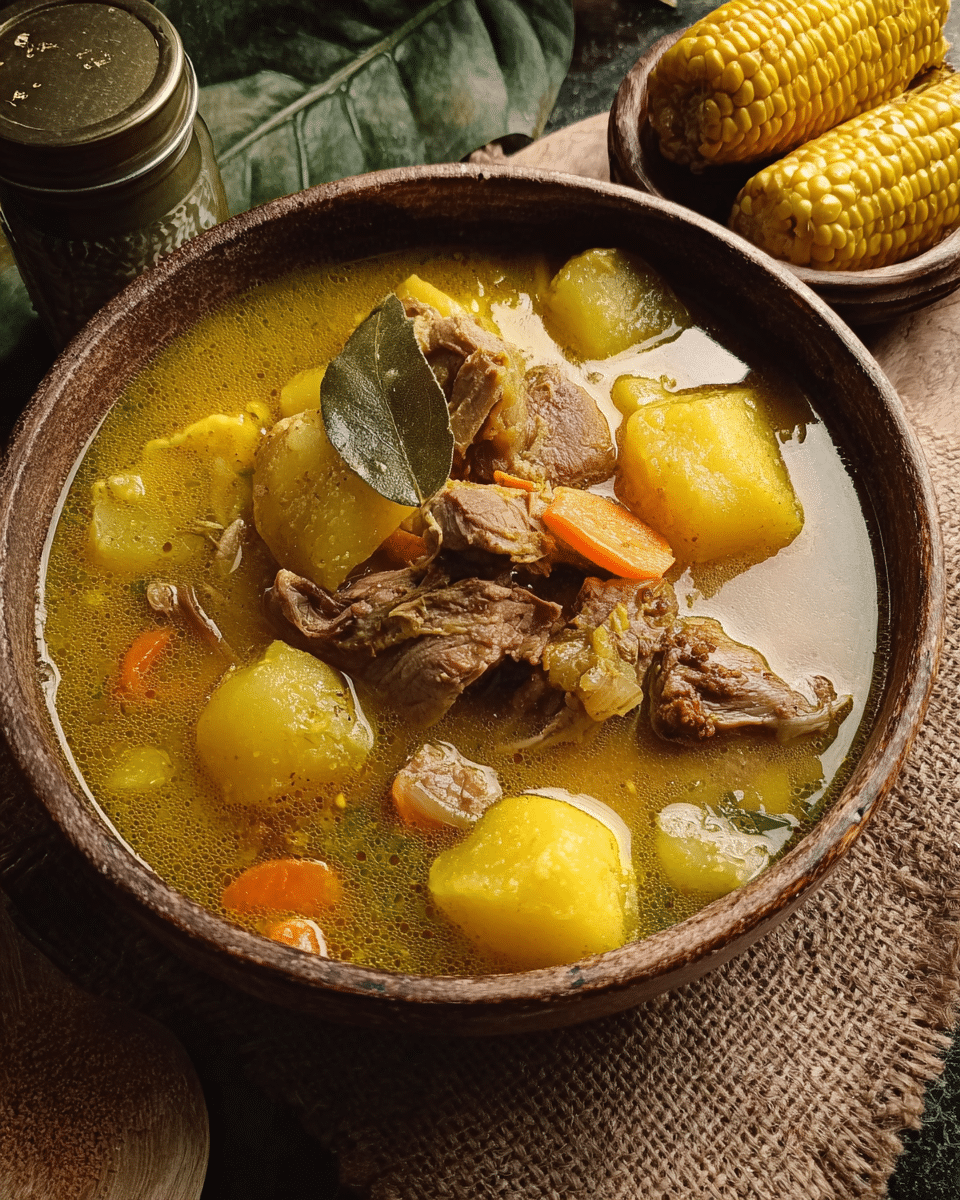Sancocho Dominicano is one of the Dominican Republic’s most treasured dishes a true celebration of culture, tradition, and family. This hearty stew is often reserved for gatherings, holidays, and special occasions, where large pots simmer for hours, filling homes with irresistible aromas. Made with a medley of meats and root vegetables like yuca, plantains, and squash, Sancocho is not only nourishing but deeply symbolic of Dominican hospitality.
Rich, savory, and packed with layers of flavor, this dish represents the island’s history and fusion of influences. Each spoonful delivers tender meat, velvety vegetables, and a broth that warms from the inside out. Whether enjoyed at a family table or shared with friends, Sancocho is more than just food it’s a story of togetherness and cultural pride served in a bowl.
Full Recipe:
Ingredients:
-
2 lbs beef (short ribs, chuck, or brisket), cut into chunks
-
1 lb chicken pieces (thighs or drumsticks)
-
1 lb pork (spare ribs or shoulder), cut into chunks
-
1 lb yuca (cassava), peeled and cut into large chunks
-
1 lb yautía (taro root), peeled and cut into chunks
-
2 green plantains, peeled and sliced into thick rounds
-
2 ears of corn, cut into halves
-
3 medium potatoes, peeled and quartered
-
1 squash (auyama), peeled and cut into large chunks
-
2 carrots, peeled and sliced
-
1 large onion, chopped
-
1 bell pepper, chopped
-
4 garlic cloves, minced
-
2 tomatoes, chopped
-
2 tablespoons tomato paste
-
1 bunch fresh cilantro
-
2 tablespoons vegetable oil
-
10 cups water or chicken broth
-
2 chicken bouillon cubes (optional)
-
2 teaspoons oregano
-
2 teaspoons ground black pepper
-
2 teaspoons salt (adjust to taste)
-
1 lime, juiced
Directions:
-
In a large heavy-bottomed pot, heat vegetable oil over medium heat. Add chicken, beef, and pork. Season with oregano, black pepper, and salt. Brown the meats on all sides for about 8–10 minutes.
-
Add onion, bell pepper, garlic, and tomatoes. Stir and cook until fragrant. Mix in tomato paste for richness.
-
Pour in water or chicken broth and bring to a boil. Add bouillon cubes if using. Reduce heat to medium-low, cover, and simmer for about 45 minutes until meat is tender.
-
Add yuca, yautía, plantains, carrots, potatoes, and corn. Continue cooking for another 30 minutes, stirring occasionally.
-
Add squash (auyama) and simmer until all root vegetables are soft and the broth is thickened, about 20 more minutes.
-
Stir in chopped cilantro and adjust seasoning with lime juice, more salt, or pepper if needed.
-
Serve hot in bowls, ensuring each portion has a mix of meat, root vegetables, and broth.
Prep Time: 20 minutes | Cooking Time: 1 hour 45 minutes | Total Time: 2 hours 5 minutes
Kcal: 420 kcal | Servings: 8 servings
Few dishes capture the heart and soul of the Dominican Republic quite like Sancocho Dominicano. This rich, comforting stew is far more than just a meal it is a celebration of culture, community, and tradition. Made with a blend of meats, root vegetables, plantains, and aromatic herbs, it is often enjoyed at family gatherings, festive occasions, and moments of togetherness. To understand Sancocho is to understand the essence of Dominican cuisine: hearty, flavorful, and steeped in history.
The Cultural Importance of Sancocho
Sancocho is not just a popular dish in the Dominican Republic it is a symbol of hospitality and family bonds. Traditionally, it is prepared in large pots to serve crowds, making it the go-to dish for holidays, birthdays, and Sunday family lunches. It is often referred to as a “celebration stew”, because of its central role in bringing people together.
In Dominican culture, preparing Sancocho is seen as an act of love. It is a communal dish, with everyone contributing whether by peeling plantains, chopping vegetables, or stirring the simmering pot. The process is as meaningful as the final result, as families gather around to cook, laugh, and share stories.
The Roots of the Recipe
The origins of Sancocho trace back to Spain, where a similar dish was introduced during colonial times. Over centuries, the Dominican version evolved to incorporate local ingredients and Caribbean influences. While Spain contributed the concept of hearty stews, the island added its unique flavor through tropical produce such as plantains, cassava (yuca), and auyama (Caribbean pumpkin).
What makes Dominican Sancocho distinct from versions found in other Latin American countries is its combination of three or more meats often chicken, beef, and pork paired with a variety of starchy vegetables. This blend creates a deep, rich broth that is both comforting and filling.
Why People Love Sancocho
There are countless reasons why Sancocho is beloved across generations. First, it is a comfort food in its truest sense: warm, hearty, and full of flavor. It satisfies both the stomach and the soul. Second, it represents togetherness, as it is rarely made in small portions there is always enough for family, friends, and neighbors.
Additionally, the versatility of Sancocho makes it appealing. While there is a traditional recipe, every family adds its own twist, whether through seasonings, types of meat, or vegetables. Some versions even include seven different meats, known as “Sancocho de Siete Carnes,” considered the ultimate luxury version of the dish.
Nutritional Value and Health Benefits
Despite being indulgent and hearty, Sancocho offers several nutritional benefits. The root vegetables provide a wealth of complex carbohydrates, fiber, and vitamins. Plantains, for example, are rich in potassium and support healthy digestion. Yuca is an excellent source of energy, while auyama adds beta-carotene and vitamin A.
The meats contribute protein and essential nutrients, making the stew both balanced and filling. Combined with herbs like cilantro, garlic, and oregano, the dish also has natural immune-boosting qualities. For those seeking wholesome comfort food, Sancocho is a powerhouse.
Serving Suggestions
Traditionally, Sancocho is served piping hot in deep bowls, with plenty of broth and a generous mix of meats and vegetables. To make the meal complete, it is often paired with white rice, which helps soak up the flavorful broth. Many also serve it with slices of ripe avocado and a squeeze of lime for brightness.
A simple salad on the side adds freshness, while crusty bread or tostones (fried plantains) provide the perfect complement. In many Dominican households, no Sancocho feast is complete without a refreshing drink like morir soñando (a citrus and milk beverage) or cold beer.
Common Mistakes to Avoid
Cooking Sancocho requires patience and attention to detail. Some common mistakes include:
- Rushing the cooking process: The stew needs time for the meats to tenderize and for the flavors to fully develop.
- Not balancing the vegetables: Overcooking plantains or cassava can make them mushy. Timing is key to keep textures intact.
- Skipping fresh herbs and seasonings: Cilantro, lime, and garlic are essential to achieving authentic flavor.
- Making it too thin or too thick: The broth should be hearty and slightly creamy from the starches, not watery or overly dense.
Variations of Sancocho
While the traditional Dominican version remains the most popular, several variations exist:
- Sancocho de Pollo: A simpler, lighter version made primarily with chicken.
- Sancocho de Siete Carnes: A grand version including seven different types of meat, usually reserved for special celebrations.
- Regional Adaptations: Some households add green bananas, malanga, or even smoked meats for extra flavor.
Each version reflects the cook’s creativity and the availability of ingredients, making Sancocho a dish that is both personal and universal.
Perfect Pairings
The rich flavors of Sancocho pair well with light, refreshing sides. Rice and avocado are classics, but you can also serve it with:
- Pickled red onions for tanginess
- Hot sauce for an extra kick
- Green salad for freshness
- Sweet fried plantains for balance
To finish the meal, Dominican desserts like flan, tres leches cake, or dulce de coco complement the hearty stew beautifully.
Why This Dish is Timeless
The enduring popularity of Sancocho lies in its blend of tradition, nutrition, and flavor. It tells a story of resilience, adaptation, and cultural pride. Every bite carries history, connecting generations who have shared this dish at weddings, birthdays, and Sunday lunches.
For Dominicans living abroad, Sancocho is often the dish that brings them back home even if only in spirit. It embodies nostalgia and comfort, making it much more than food.
Conclusion
Sancocho Dominicano is more than a stew it is a symbol of Dominican identity, family, and celebration. Its rich combination of meats, vegetables, and herbs makes it both nourishing and indulgent. Whether you enjoy it at a festive gathering or on a rainy day, it never fails to bring warmth and satisfaction.
If you want to experience the heart of Dominican cuisine, cooking Sancocho is the perfect place to start. It captures the island’s history, culture, and hospitality in one bowl, reminding us that food is not only about sustenance it’s about community and love.






